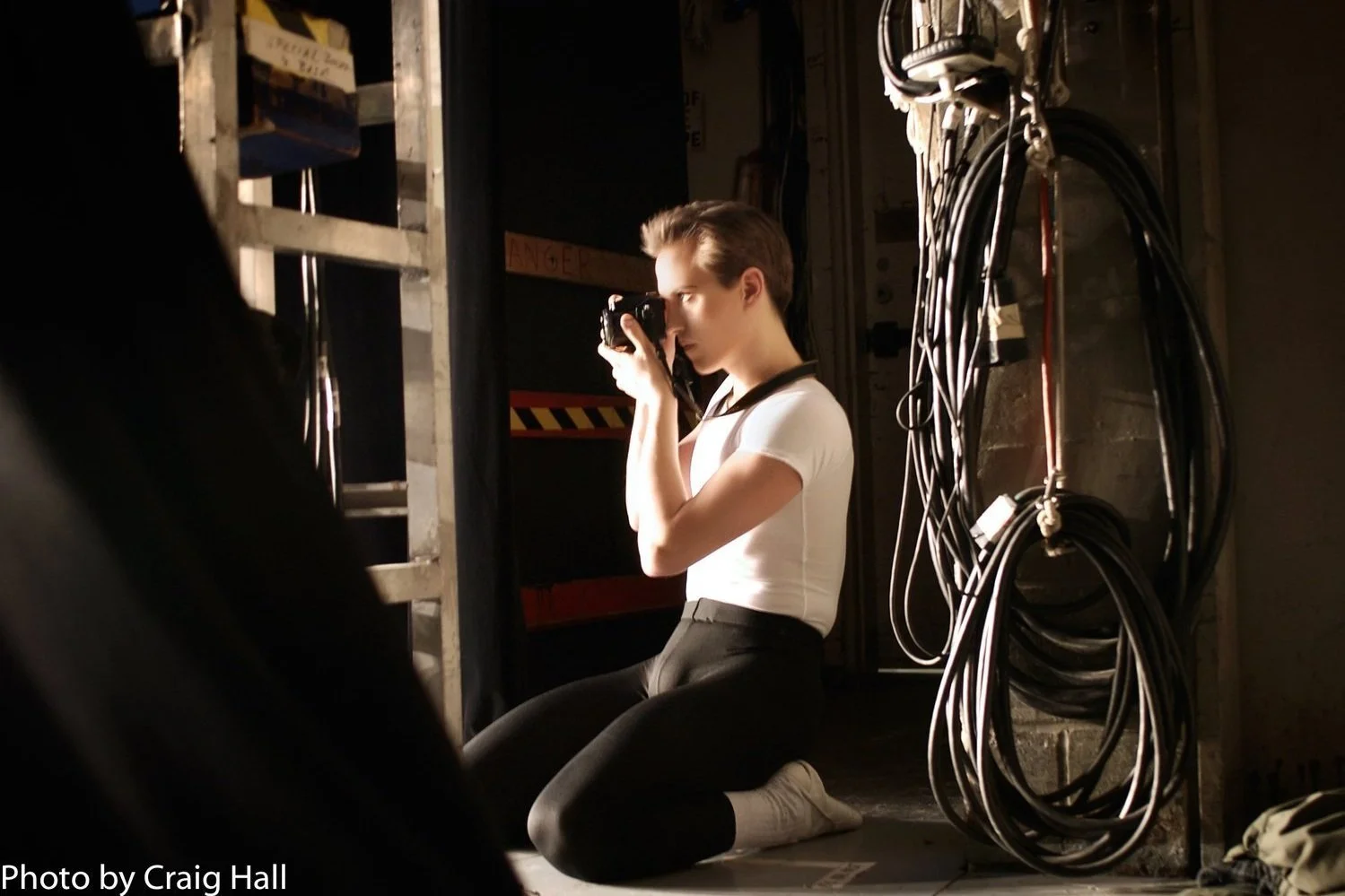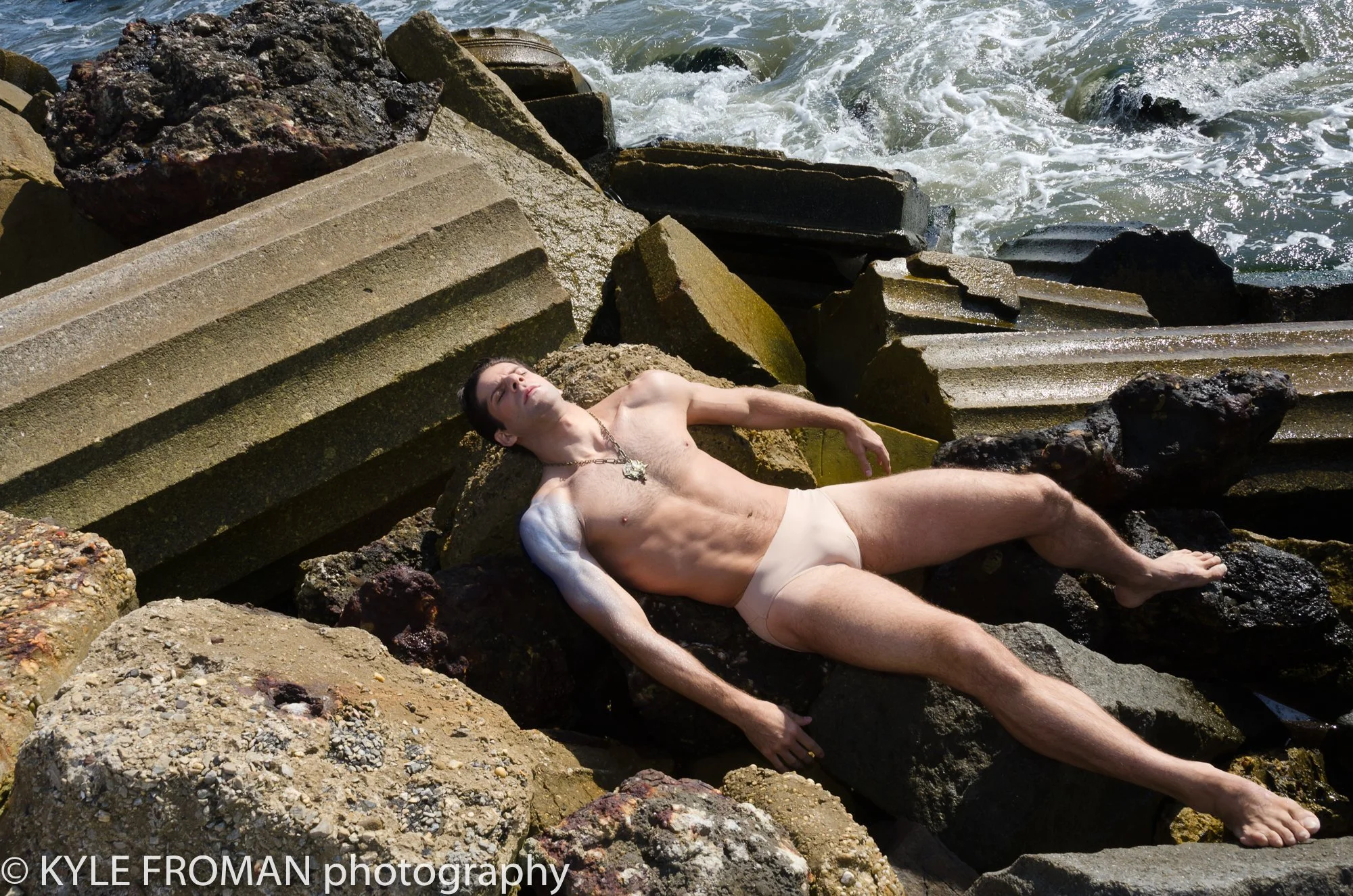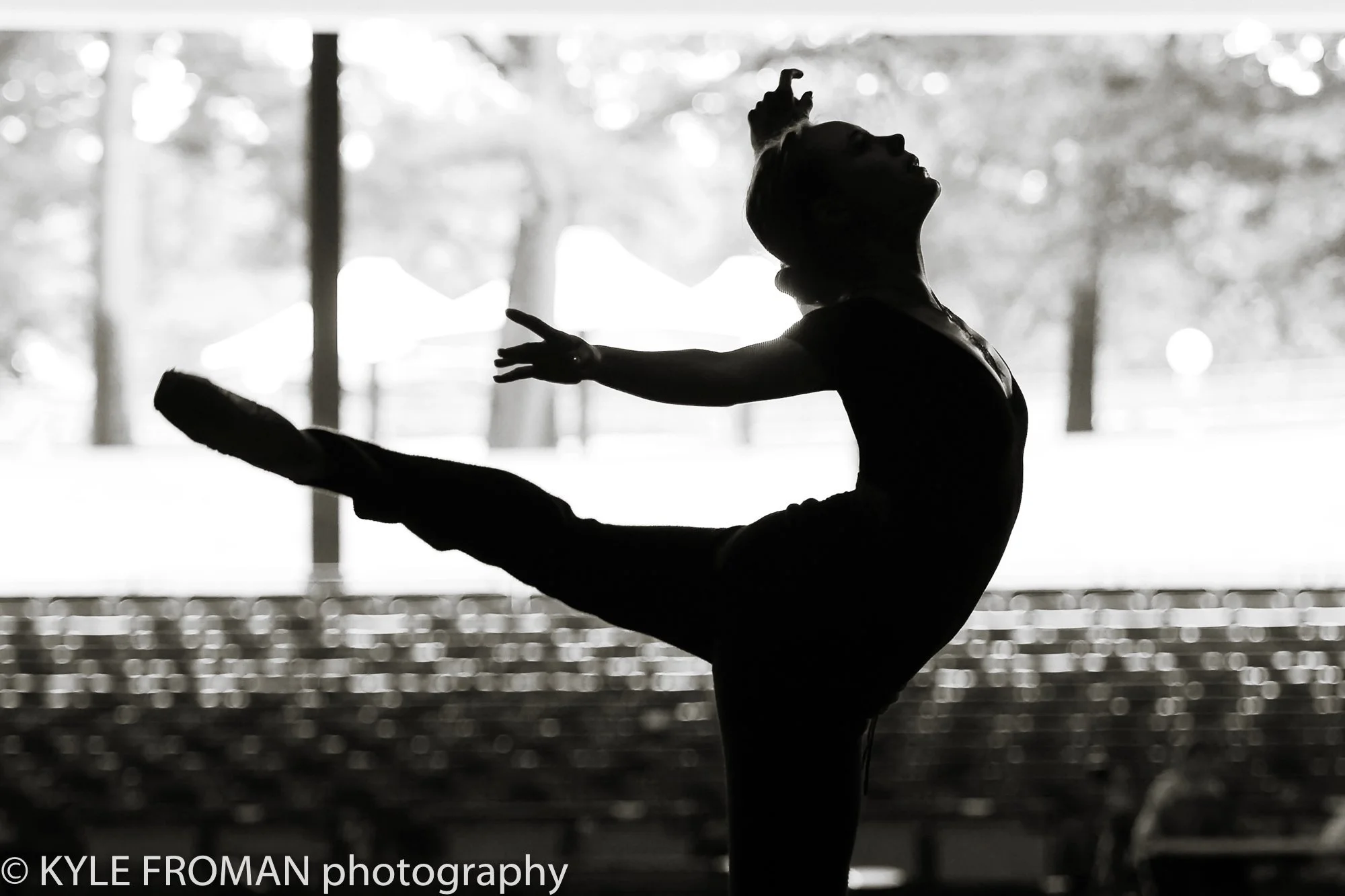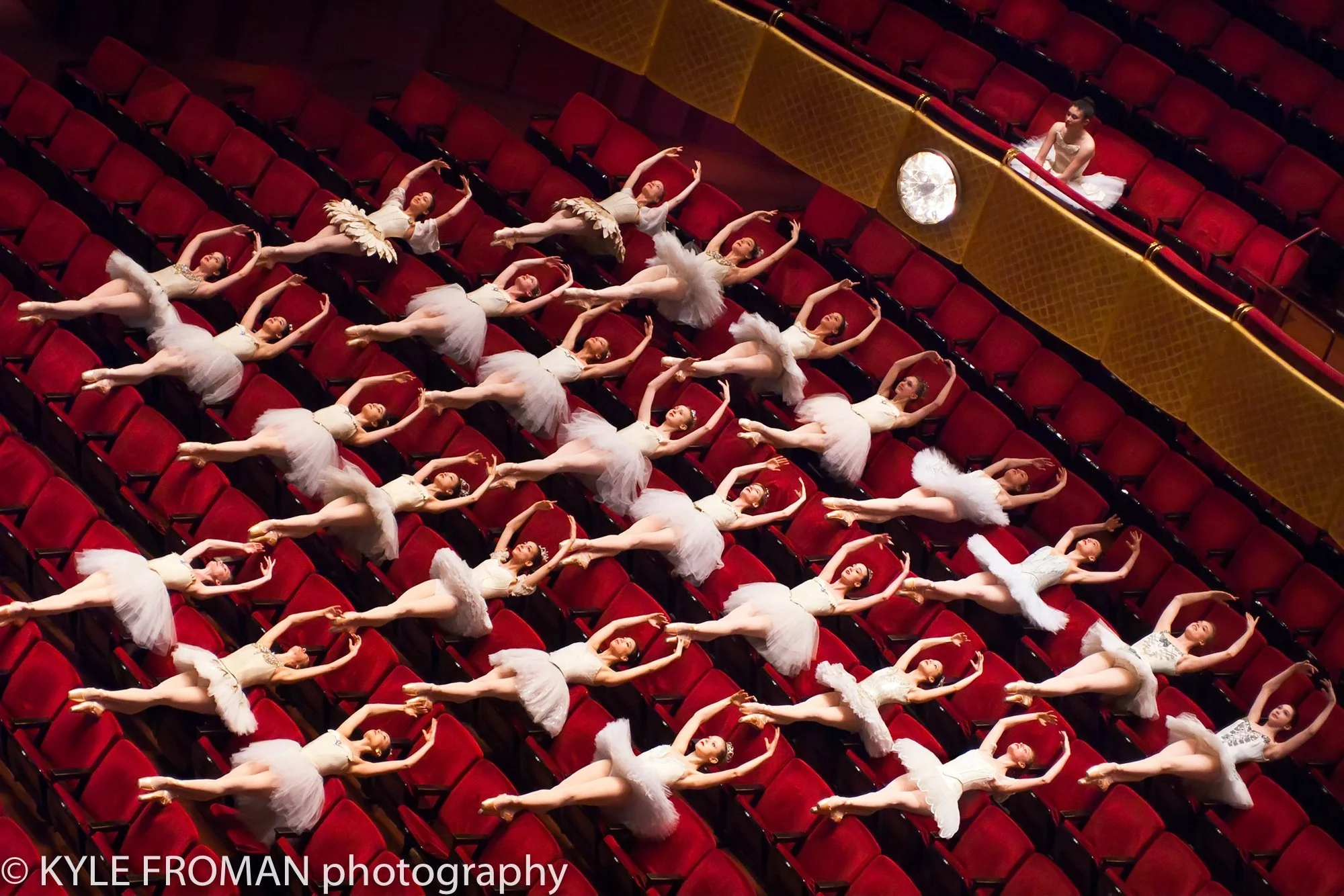Kyle Froman on Transitioning from a Dance Career
My life as a dancer came to an end on February 15, 2009. That was the day I retired from the New York City Ballet. I knew a career transition was coming soon, but I hadn’t decided on the date until two weeks before. It was better that way for me. Two weeks gave me just enough time to say goodbye to the ballets I had left to dance without giving me too much time to second-guess myself. I was going to be a full-time photographer, and I couldn’t wait to experience my new life.
The day’s program included two of my favorite ballets to dance, with Balanchine’s Stravinsky Violin Concerto first on the program. I was happy to have a “leotard ballet” as part of my sendoff. Balanchine outfitted many of his plotless neoclassical ballets in simple practice clothes when sets and costumes weren’t essential. It was his way of simplifying ballet to the most basic elements, with the dancers’ fine-tuned bodies on full display. The uniform of leotards and tights became one of his trademarks. There was a strength to the look, but also a sexiness, like spandex pulled tight over marble.
Jerome Robbins’ West Side Story Suite concluded the performance. It was an especially bittersweet piece to end a dance career with. The finale has almost the entire cast onstage, all looking out into the audience and singing the last few bars of “Somewhere,” our arms raised at our sides. For a few seconds, there’s a stillness with no music and no movement onstage. Time seemed to stretch out for me that day, giving me an extra moment to take it all in. Searching through the blackness, I saw for a final time the dimly-lit jewels adorning the theater’s tiers of seats, and I appreciated the gift I’d been given of fourteen years spent dancing on that stage. Then, we slowly lowered our arms and bowed our heads as the curtain fell.
It was over.
Video taken in the dressing room immediately afterward sticks out in my mind. I appear bare-chested but still partially in costume as a member of the Jets, wearing a pair of jeans, sneakers, and a face covered in stage makeup. “Say goodbye to all of this,” I joke to the camera while pointing at my lean torso. I may have been talking to my husband holding the camera, or maybe myself. I knew a physical change would probably take place by leaving ballet behind, so I was happy my dancer’s body was having its farewell appearance captured on tape for posterity.
Compared to the world-class ballet dancers who were my colleagues, I had my share of shortcomings. But I’d always been thin, long-limbed, and flexible. I had pretty good turnout and musicality, but above all, I liked to work hard. My devotion to the New York City Ballet was total since I was fourteen, years before I’d even moved up to the city from Texas. It had been my life’s dream to be a dancer in the company, and I achieved that goal at 18 years old.
“You’re lucky. Your job keeps you in shape,” my husband remarked when we first started dating. “Most people get heavy when they work too much. You get thinner.” I knew he was right, but the perks of being a ballet dancer were what was wearing thin for me by then. I was tired of feeling different, shut off from the world outside of the theater without any kind of work/life balance. When I did venture outside my dancers’ bubble, I felt conspicuous in myriad ways—walking down the street with turned-out feet, appearing malnourished or exhausted in the middle of a season, or eating in a restaurant with traces of eye makeup still on my face from the show.
Also, I knew it was an impossible job to have forever, and though I wasn’t old even for a dancer, my shelf life was naturally compared to younger dancers. I began wondering what was next for me. I longed to find something I loved as much as ballet, and I was relieved when I developed both a passion and skill for dance photography.
I wasn’t reliant on my body when I took photos. I was no longer a piece of meat. Taking pictures was something I could do no matter my age or my weight or how good my feet were. All the judgement I’d directed at my body for years could stop. When I retired, I would shed my ballet dancer’s skin.
It happened quickly. I visited the theater at the beginning of the company’s spring season in April, and the first thing out of the hair and makeup person’s mouth to me were, “You’ve gotten fat!” I laughed and said I knew. It was a badge of honor that my job didn’t depend on my appearance anymore, and I’d overindulged in my newfound freedom. Instead of a routine of daily class, rehearsals, and performances, I now sat in front of my computer for hours every day eating anything I wanted. I wasn’t surprised I’d gained almost fifteen pounds in two months.
No one told me what transitioning from being a dancer would be like, much less what becoming my own boss would be like. But I knew that it was up to me if I succeeded or failed, and I trusted the work ethic that was ingrained in me. The world felt big and wonderful, and I was happy to discover the life lessons that awaited.
I threw myself into my new job over the coming months, spending every bit of energy I had toward growing my business, lining up shooting gigs, and taking photos. The job was both exciting and draining, but it was the new physical effects of a nonphysical job that stood out. My back cramped from sitting in front of the computer, and I began having pangs in my legs that I assumed were from not moving or stretching. I viewed the sensations as growing pains as I transitioned into a normal person’s shape. My creativity and photo skills were what mattered now, so I did my best to erase the body awareness I’d spent years refining. What I couldn’t ignore was what my career change started doing to my brain.
Marcelo Gomes, former principal dancer with American Ballet Theatre, photographed in 2012 as part of Froman’s photo series of dancers with architecture, Bodies/Buildings.
I’ve always been an anxious person, so surges of adrenaline, shallow breathing, and stomach aches were completely normal for me. But I never realized how I regulated those feelings with dancing. Now, without the daily physical exertion that came with being a dancer, my anxiety had grown out of control, like an overlooked weed. Almost out of the blue, but like clockwork, I found myself overcome with full-fledged panic by late-afternoons, like someone was sitting on my chest.
Along with the anxiety, I was depressed about how I looked. The “normal” body I couldn’t wait to have now made me feel ugly. My clothes didn’t fit anymore, and I hated what I saw in the mirror. While my feet had been the culprit in my past life, now it was my stomach. I hadn’t realized how much of my self-worth came from looking a certain way. Now that it was gone, I felt like a failure and wondered if the damage I’d done was irreparable.
I’d been a professional athlete for half of my life, but I didn’t know how to get in shape without putting myself back in a dance studio. Doing that felt like some sort of defeat, since I didn’t miss dancing. Desperate, I started making sporadic trips to the gym up the street with equally irregular results.
The gym was a foreign country to me, and I couldn’t help but feel out of place no matter how many times I went. Macho aggressiveness seemed to thicken the air, especially around the free weights. The muscle-heads and gym regulars who filled the benches grunted loudly and shook the floor with dropped dumbbells, so I gravitated toward the elliptical machines in the front. There, I could put on my headphones and close my eyes as the minutes dragged on. Sometimes I’d listen to music from ballets I’d spent years performing and imagine myself onstage again. I’d open my eyes and wonder who could believe I was recently a professional ballet dancer.
I scanned the room of strangers working out around me. How did they know what to do? Who was going to hurt himself by lifting wrong? What was the proper technique anyway? Curious, I concentrated on the trainers. Which of them was the best? What would it feel like to work with one?
Sara Mearns, NYCB principal dancer, photographed in 2006 while rehearsing Peter Martins’ Swan Lake at the Saratoga Performing Arts Center.
From my spot on the elliptical machine, a brown-haired trainer in his twenties stood out to me. He sported the same black T-shirt with “Look Better Naked” emblazoned across the chest that the rest of the instructors wore, but there was a noticeable difference in his training style. He wasn’t distracted by his cell phone while working with clients and only carried a small notebook he’d occasionally jot entries in. There was a thoughtful quality to him, and he seemed a stickler for form. I chuckled when he slowed his client’s movements down to a snail’s pace so that each repetition was perfect. It reminded me of different ballet teachers I’d had, and I knew the agony the client must have felt.
As he circled his charge and made tiny adjustments to the man’s shoulder, knees, and head, I made mental notes of the exercises. Yet it wasn’t the same when I tried to replicate it for myself. I knew to really make a difference, I needed to feel accountable to someone, a trainer who knew what he was doing. As the winter holidays approached, I bit the bullet and hired him. His name was Jonathan Keltai.
“What are your goals?” he asked after starting me on the stationary bike our first session. I told him about my history and trouble getting back in shape, and I confessed that I didn’t really know what I was doing. My goals, I told him, were typical of most people—I wanted to lose weight and gain muscle. What Jonathan gave back to me over time was life-changing.
As he guided me through an exercise series involving machines and free weights, Jonathan formulated a workout plan. I’d strength-train three days a week (two with him), and alternate those days with what he called “active recovery” days, where I’d come in and not give 100%, but would do light cardio or Pilates. His focus would be on resistance training and getting me stronger. He promised that the more capable I became, the more it would show aesthetically. In six months, he told me, my friends would notice a difference in how I looked.
I scoffed at the notion it would take me six months to show results and swore it would only take me six weeks. I continued by asking him to work me so hard every session that I wouldn’t be able to even think. I also didn’t mind throwing up if it came to that.
It was an extreme response to his slow and steady plan, and Jonathan countered with words of wisdom. What was important for me was to learn to balance things. “I want you to give effort, both in the gym and with your diet, but I don’t want you to push too hard too often. Punishing yourself doesn’t help in the long run. Instead, focus on enjoying the process so you stay consistent.”
“Red Seats,” from a series Froman conceived and shot for a New York City Ballet gala in 2008.
I trained twice a week with him over the next three years, and it broke the spell for me. As the months passed, my body slimmed down, and I put on more upper body muscle than I’d ever had. I felt like I was learning a new language, and Jonathan made it make sense. He also taught me to trust the process. If my pull-ups or bench press felt off one day, I invariably felt better coordinated the next time I tried.
I felt both freed and focused, a sensation I hadn’t felt since my dancing days. The gym became my second home, where I averaged six visits a week. Like ballet class, it was wonderful to establish a morning routine of working out, and I felt the connection to my body gradually return.
The struggle of lifting weights brought the reward of flowing endorphins, something I hadn’t really felt since my retirement performance. With 60 lb. dumbbells raised over my face, I realized I hadn’t felt so alive, with that level of focus, in years. I had to be in the moment or the result would be disastrous. Yet faced with the danger, I felt calm.
The workouts left me clearheaded and energized, and adding them to my schedule made me realize I needed moderation and structure in other parts of my life. My tendency as a dancer was to give every bit of myself to one thing, but working ten hours in front of the computer wasn’t beneficial if I was a nervous wreck by the end. With this moderation came the feeling that I’d learned something, a life lesson. I was becoming a functioning, normal person.
I’ve been at my dancing weight for two years now, and I didn’t have to return to a ballet studio to do it. In a sense, I shed my skin again and am happy with how I look. Mostly, I’m happy that I could achieve it by learning something new and going down a path I hadn’t seen before.





